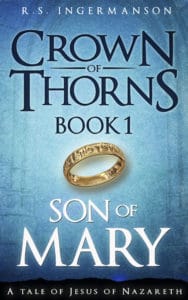Three of the gospels report a very strange incident at Nazareth. Jesus had spent some months making a name for himself all around Galilee. Then he came back to his hometown. And the villagers gave him a very cold shoulder.
You can read all about it in Mark, in Matthew, and in Luke. Each of these gives us unique information.
What Mark Tells Us
Mark is our earliest gospel, and it tells the story in Mark 6:1-6. Jesus came to Nazareth with some of his disciples and was asked to teach in the synagogue on the Sabbath. Mark reports that the villagers were astonished at both his wisdom and his mighty works.
This passage is notable because it’s the only verse in the entire Bible that tells us Jesus’s occupation. The villagers ask, “Isn’t this the tekton, the son of Mary?” The Greek word “tekton” means one who works in wood, metal, or stone. This has traditionally been translated “carpenter” in English, but we don’t actually know if Jesus specialized in wood. We truly don’t have any other Biblical data.
Now why did the villagers refer to Jesus as the “son of Mary?” Was this because his father Joseph was dead? Or was it a sneering reference to the rumors that Joseph was not the blood father of Jesus? We don’t know exactly what the villagers meant here. But we know they had a problem with him, so it’s quite plausible that they were throwing shade on him.
The passage is one of only two places in the Bible that refer to four “brothers” of Jesus by name—James, Joses, Judah, and Simon. And it mentions “sisters”—but with no number to tell us how many siblings Jesus had. Scholars have debated exactly how these “brothers” were related to Jesus. Were they sons of both Joseph and Mary? Were they sons of Joseph by some earlier wife? Were they cousins of Jesus?
We learn from this passage that the village was offended by Jesus and that he healed a few sick people but didn’t do anything more spectacular. But the reason they took offense is unclear.
If Mark’s account was all we knew, it would still be immensely valuable to us. But Matthew has some things to add.
What Matthew Tells Us
Matthew’s gospel was probably written about a decade after Mark, and it often follows Mark very closely. Most biblical scholars believe that Matthew used Mark’s gospel as a source.
Matthew tells the story in Matthew 13:54-58. He follows Mark’s account very closely, with a couple of changes that give us new information.
In Matthew’s account, the villagers don’t directly say that Jesus was a “tekton.” They say that his father was. The villagers asked, “Isn’t this the son of the tekton? Isn’t his mother called Mary?”
This is certainly less insulting than in Mark’s account. Here, Jesus is named as the son of his father, rather than the son of his mother. In a patriarchal society, that matters.
Matthew also names the four “brothers” of Jesus, but he puts them in a different order—James, Joses, Simon, and Judah. The names of the third and fourth brothers are swapped. What’s the reason for that? Was Matthew a sloppy copyist? Or did he believe that Mark had got the order backwards, and that the record should be set straight? We don’t know.
Again, Matthew makes it clear that the village took offense at Jesus, but it’s still not clear why.
Luke tells us yet a different version of things, and here we find a surprise.
What Luke Tells Us
Luke’s gospel is generally thought to have been written after both Mark and Matthew. His account is found in Luke 4:16-30, which is considerably longer than the other two versions.
Luke tells us quite a bit about what Jesus actually taught. Jesus was given the Isaiah scroll, and he read a passage that his listeners would have known well, Isaiah 61:1-2.
But he broke off the passage in the middle. He stopped literally in the middle of a sentence—just before Isaiah’s words on the Day of Vengeance.
Why did he stop there? What did the villagers think about this interruption? Was that why they took offense? Or was there more to it than that?
In Luke’s account, this is the point where the villagers say, “Isn’t this Joseph’s son?” There is no mention of Mary here. There is no mention of the brothers or sisters.
But what comes next is very telling. Jesus now says that they want him to do miracles like he’s done in Capernaum (and presumably in many other villages in Galilee). It looks like there’s the rub—Jesus had made a name for himself in other places, doing mighty miracles, but he didn’t do them in his own hometown first.
When Jesus starts talking about a pagan widow who honored the prophet Elijah and a pagan leper who was healed by the prophet Elisha, the villagers have had enough.
They rise up in a mob, grab Jesus, and drag him to “the precipice,” intending to throw him off. If you go to Nazareth today, you’ll be shown the traditional Mount Precipice, which is a fairly steep slope, studded with boulders. It’s not exactly a cliff, but you could certainly kill a man by throwing him over the edge and then tossing rocks on him (the traditional method for stoning a person).
Mount Precipice is a bit more than a mile from the actual village. That’s quite a hike. This mob sounds like it was extremely angry. Or else the whole thing was well-planned in advance. We can’t say for sure.
Luke tells us that Jesus “passed through the midst of them” and went on his way.
OK, what??? How did that happen? Clearly, there’s more to the story than just walking through the mob, but Luke doesn’t tell us how it happened. Did Jesus fight? Did his disciples fight? Did his brothers fight? Did God intervene? What happened at the precipice? Why did Jesus wait until the very last second to get out of trouble?
We don’t know, and there’s no way to find out. The best we can do is guess.
Novelists Make Guesses

We don’t know exactly what happened in the incident at Nazareth.
But the incident is a crucial set of scenes in my brand-new novel Son of Mary, which is Book 1 in my long-anticipated Crown of Thorns series.
Son of Mary is now on Amazon! I’ve set the e-book up for pre-order, and it will officially release on Palm Sunday, April 5, 2020. The paper edition is already up for sale now.
The novel plays on all the issues I’ve highlighted in this blog post. The ugly rumors about the legitimacy of Jesus. The brothers of Jesus. The attitude of Nazareth toward their most famous son. Their attitude toward his mother.
And the terrifying incident at Nazareth.
Let’s be clear—we can’t be certain about any of these things. But a novelist is allowed to make guesses. It’s just a story, and nobody thinks a novel tells the exact way things worked out. A novel creates a movie in your head, showing you one possible way it could have happened.
That’s all.
But that’s enough.
You’ll love Son of Mary because it will show you the Jesus you’ve always known in a whole new way. Enjoy the ride.

Randy, Reading your City of God series has been one of the most enjoyable experiences of my life. You had me on the edge of my seat the whole time. I loved every minute. The characters have become so real to me. I feel as though I know them personally and the way you tied them together in Double Vision with the cousin of Rivka….. pure genius. I “can’t wait to see what happens next” in the City of God series!
And now the Crown of Thorns……. I just ordered my copy from Amazon. I love your work and the “muse”or whatever it is that expresses itself through your writing.
Wishing you good fortune and happiness,
Joe